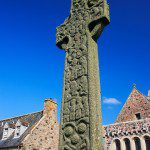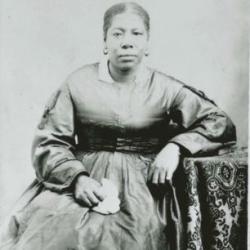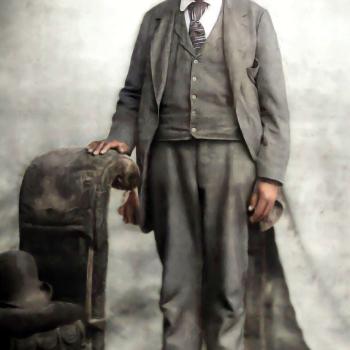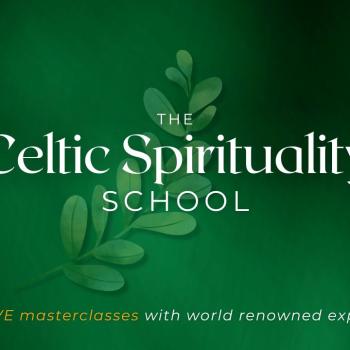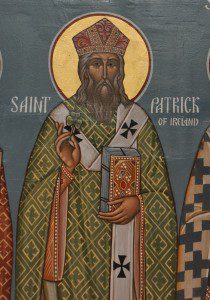
Patrick of Ireland may be a well-known saint, but that is thanks to the day that bears his name — March 17 — which for most people is more about green beer than anything else.
But Patrick himself is shrouded in myth and legend — so much so that it’s virtually impossible to separate history from fable.
Some of the most charming and memorable stories associated with the saint — such as his using the shamrock to explain the holy trinity to the pagan Irish, or commanding the snakes to leave Ireland — belong firmly in the category of folklore. But mythology is not meant to be history — its purpose is spiritual. Myths are told, and retold, to convey spiritual meaning at a level independent of whether a story is “true” in a scientific or scholarly sense. This is why modern fantasy literature, ranging from The Lord of the Rings to The Chronicles of Narnia and even the Harry Potter stories, touch the lives of so many people. Not only are they entertaining tales, but they are mythic tales, filled with insight and inspiration regarding the meaning of life.
So let us approach the stories of St. Patrick the same way.
We’ll begin with what little we do know about this important Celtic saint. Born probably sometime in the early fifth century, Patrick hailed from a Christian family — his father was a deacon, and his grandfather a priest (this was before celibacy became mandatory for Catholic priests). The location of Patrick’s childhood home is unknown, although he probably was British, Scottish or Welsh. By his own admission, he was not a particularly pious child, and he blames his spiritual indifference for the tragedy which befell him at age 16. Pirates from Ireland captured the youth, and sold him into slavery.
Given the task of shepherding, the young slave often spent many hours in isolation. It was during this time that he began to more seriously attend to his spiritual life, praying and seeking God’s presence. His reward? After six years of slavery, he received a locution — a mystical voice saying “Your ship is ready,” instructing him to run away and seek his freedom. Traveling many miles as a fugitive, he eventually reached the coastline where the penniless but prayerful runaway had to talk a ship’s captain into giving him passage. The ship and its crew eventually landed (whether in Great Britain or mainland Europe, no one can say) and after various adventures, Patrick, now a young man in his twenties, finally returned home.
But not for long.
One night Patrick had a dream — or was it a vision? — In which a man named Victoricus came to him, from Ireland, holding “countless” letters. Taking one, Patrick read it, seeing that the letter was titled “The Voice of the Irish.” As he read the letter it seemed as if he could hear the voices of the Irish people, begging him to return to the land where he was enslaved.
Patrick reports in his autobiography that this left him heartbroken. The dream ended with him refusing or unable to read any of the many other letters. But apparently the seed was planted, and after a few years passed by, the young man — now ordained a missionary for Christ — returned to the place of his captivity, and spent the rest of his life sharing the Christian Gospel with the pagan Irish, and fighting human trafficking.
Was Patrick truly the first Christian to evangelize Ireland? Probably not. Records show another missionary named Palladius served as the first bishop of Ireland, perhaps a generation or two ahead of Patrick. But for whatever reason, Patrick has captured the imagination of the Irish people, and therefore the world, as the man who brought Christianity to Ireland, and in doing so, brought elements of Celtic spirituality to the Christian community at large.
Enjoy reading this blog?
Click here to become a patron.
I’ve already mentioned Patrick’s reputation for pest control (at least as far as snakes are concerned); never mind that the snakes probably were separated from Ireland during the last ice age. Using the shamrock as a teaching aid is probably another charming legend — pagan Celtic mythology has such a strong appreciation of the number 3, or “tripleness,” that Patrick probably found the Irish more than willing to accept the idea that one God included three persons. But perhaps the most fascinating legend associated with the saint is the story of is breastplate, or lorica (from the Latin word for corselet). In Celtic literature, a lorica is a prayer or incantation for protection. The story goes that Patrick and some fellow evangelists were traveling through an unfriendly part of Ireland, where they were at risk of being attacked by hostile pagans. So as they travelled in the region, Patrick began to intone this particular supplication to keep his company safe.
I bind unto myself today
The strong name of the Trinity,
By invocation of the same,
The Three in One and One in Three.I bind this day to me for ever,
By power of faith, Christ’s Incarnation;
His baptism in the Jordan River;
His death on cross for my salvation;
His bursting from the spicèd tomb;
His riding up the heavenly way;
His coming at the day of doom;
I bind unto myself today.I bind unto myself the power
Of the great love of the Cherubim;
The sweet ‘Well done’ in judgment hour;
The service of the Seraphim,
Confessors’ faith, Apostles’ word,
The Patriarchs’ prayers, the Prophets’ scrolls,
All good deeds done unto the Lord,
And purity of virgin souls.I bind unto myself today
The virtues of the starlit heaven,
The glorious sun’s life-giving ray,
The whiteness of the moon at even,
The flashing of the lightning free,
The whirling wind’s tempestuous shocks,
The stable earth, the deep salt sea,
Around the old eternal rocks.I bind unto myself today
The power of God to hold and lead,
His eye to watch, His might to stay,
His ear to hearken to my need.
The wisdom of my God to teach,
His hand to guide, his shield to ward,
The word of God to give me speech,
His heavenly host to be my guard.…
Christ be with me, Christ within me,
Christ behind me, Christ before me,
Christ beside me, Christ to win me,
Christ to comfort and restore me,
Christ beneath me, Christ above me,
Christ in quiet, Christ in danger,
Christ in hearts of all that love me,
Christ in mouth of friend and stranger.I bind unto myself the name,
The strong name of the Trinity;
By invocation of the same.
The Three in One, and One in Three,
Of whom all nature hath creation,
Eternal Father, Spirit, Word:
Praise to the Lord of my salvation,
salvation is of Christ the Lord. (Translated by C. F. Alexander, 1889)
The legend goes that as Patrick and his company chanted this prayer for protection, they shapeshifted into deer, able to move through the woods and avoid any danger from their druidic enemies (apparently the druids were not deer hunters!). So now this particular poem is known as “St. Patrick’s Breastplate” or “The Deer’s Cry,” and hymns using these words get sung in churches to this day, especially on Trinity Sunday.
It’s just a fable, of course, and the lorica has roots in pagan times as a rune or charm of protection. The historical St. Patrick did not write these words, most scholars date the Deer’s Cry to about the 8th century, several hundred years after Patrick’s death. But it will forever be associated with the Irish saint.
So what is the wisdom of St. Patrick? Historically speaking, what really stands out is his courage — his dignity during years of enslavement, followed by taking advantage of a chance to liberate himself, only to eventually return to the very people who oppressed him, in the interest of bringing spiritual wisdom to them. The heard of Christianity is forgiveness and mercy, and Patrick seems to embody those values well.
As for the legendary side of Patrick, the lorica shimmers with lyrical beauty, invoking a God who loves nature, who comes close to protect those who love Him, and who is found in all things — not only in the “stable earth, the deep salt sea, the old eternal rocks” but also in the “hearts of all that love me,” and the “mouth of friend and stranger.”
Other verses of the Deer’s Cry are a bit harder to take, filled with fearful imagery of sin and magic that threaten to undo the one seeking God’s protection.
For us today, Patrick — both the man and the myth — stands for a variety of spiritual values, from listening carefully to the voice of God, forgiving and helping those who have harmed us, to seeking Divine care and comfort literally in all things. It’s a spirituality that calls us to deep trust and profound hope.
Enjoy reading this blog?
Click here to become a patron.



